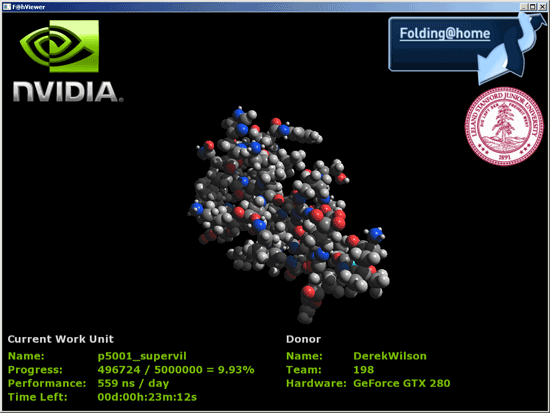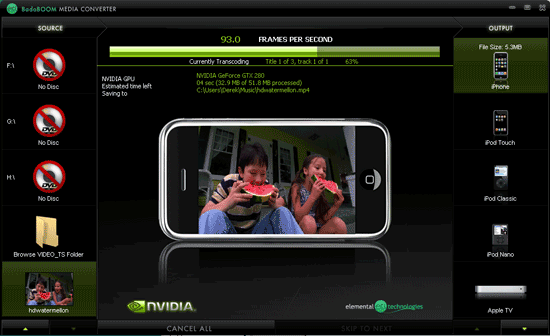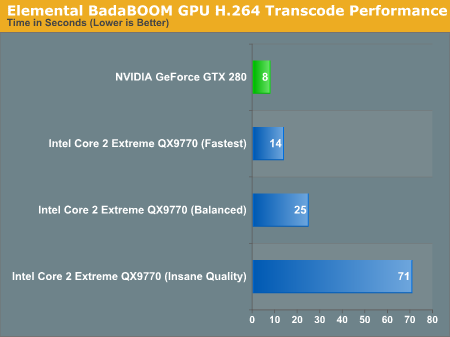NVIDIA's 1.4 Billion Transistor GPU: GT200 Arrives as the GeForce GTX 280 & 260
by Anand Lal Shimpi & Derek Wilson on June 16, 2008 9:00 AM EST- Posted in
- GPUs
Folding@home Now on NVIDIA
Folding@home, for those who don't know, is a distributed computing app designed to help researchers better understand the process of protien folding. Knowing more about how protiens assemble themselves can help us better understand many diseases such as alzheimers, but protien folding is very complex and takes a long time to simulate. the problem is made much easier by breaking it up into smaller parts and allowing many people to work on the problem.
Most of this work has been done on the CPU, but PS3 and AMD R5xx GPUs have been able to fold for a while now. Recently support for AMD's R6xx lineup was added as well. NVIDIA GPUs haven't been enabled to run folding@home until now (or very soon anyway). Stanford has finally implemented a version of folding@home with CUDA support that will allow all G80 and higher hardware to run the client.

We've had the chance for the past couple days to play around with a pre-beta version of the folding client, and running folding on NVIDIA hardwarwe is definitly very fast. Work units and protiens are different on CPUs and GPUs because the hardware is suited to different tasks, but to give some perspective a quadcore CPU could simulate tens of nanoseconds of a protien fold, while GPUs can simulate hundreds.
While we don't have the ability to bring you any useful comparative benchmarks right now, Stanford is working on implemeting some standard test cases that can be run on different hardware. This will help us actually compare the performance of different hardware in a meaningful way. Right now giving you numbers to compare CPUs, PS3s, AMD and NVIDIA GPUs would be like directly comparing framerates from different games on different hardware as if they were related.
What we will say is that NVIDIA predicts that the GTX 280 will be capable of simulating something between 5 and 6 hundred nanoseconds of folding per day while CPUs are going to be two orders of magnitude slower. They also show the GTX 280 handily ahead of any current AMD solutions by high margins, but until we can test it ourselves we really don't want to put a finer point on it.
In our tests, we've actually seen the GT200 folding client perform at between 600 and 850ns per day (using the timestamps in the log file to determine performance), so we are quite impressed. Work units complete about every 20 to 25 minutes depending on the protien and whether or not the viewer is running (which does have a significant impact since the calculations and the display are both running on the GPU).
Hardware H.264 Encoding
For years now both ATI and NVIDIA have been boasting about how much better their GPUs were for video encoding than Intel's CPUs. They promised multi-fold speedups in performance but never delivered, so we've been stuck encoding and transcoding videos on CPUs.
With the GT200, NVIDIA has taken one step closer to actually delivering on these promises. We got a copy of a severely limited beta of Elemental Technologies' BadaBOOM Media Converter:

The media converter currently only works on the GeForce GTX 280 and GTX 260, but when it ships there will be support for G80/G92 based GPUs as well. The arguably more frustrating issue with it today is its lack of support for CPU-based encoding, so we can't actually make an apples-to-apples comparison to CPUs or other GPUs. The demo will also only encode up to 2 minutes of video.
With that out of the way however, BadaBOOM will perform H.264 encoding on your GPU. There is still a significant amount of work being done on the CPU during the encode, our Core 2 Extreme QX9770 was at 20 - 30% CPU utilization during the entire encode process, but it's better than the 50 - 100% it would normally be at if we were encoding on the CPU alone.
Then there's the speedup. We can't perform a true apples-to-apples comparison since we can't use BadaBOOM's H.264 encoder on anything else, but compared to using the open source x264 encoder the performance speedup is pretty good. We used AutoMKV and played with its presets to vary quality:

In the worst case scenario, the GTX 280 is around 40% faster than encoding on Intel's fastest CPU alone. In the best case scenario however, the GTX 280 can complete the encoding task in 1/10th the time.
We're not sure where a true apples-to-apples comparison would end up, but somewhere between those two extremes is probably a good guesstimate. Hopefully we'll see more examples of GPU based video encoder applications in the future as there seems to be a lot of potential here. Given how long it takes to encode a Blu-ray movie, we needn't even explain why it's necessary.










108 Comments
View All Comments
Chaser - Monday, June 16, 2008 - link
Maybe I'm behind the loop here. The only competition this article refers to is some up coming new INTEL product in contrast to an announced hard release of the next AMD GPU series a week from now?BPB - Monday, June 16, 2008 - link
Well nVidia is starting with the hi end, hi proced items. Now we wait to see what ATI has and decide. I'm very much looking forward to the ATI release this week.FITCamaro - Monday, June 16, 2008 - link
Yeah but for the performance of these cards, the price isn't quite right. I mean you can get two 8800GTs for under $400 and they typically outperform both the 260 and the 280. Yes if you want a single card, these aren't too bad a deal. But even the 9800GX2 outperforms the 280 normally.So really I have to question the pricing on them. High end for a single GPU card yes. Better price/performance than last generations card, no. I just bought two G92 8800GTSs and now I don't feel dumb about it because my two cards that I paid $170 for each will still outperform the latest and greatest which cost more.
Rev1 - Monday, June 16, 2008 - link
Maybe lack of any real competition from ATI?hadifa - Monday, June 16, 2008 - link
No, The reason is high cost to produce. over a Billion transistors, low yields, 512 bit bus ...
Unfortunately the high cost and the advance tech doesn't translate to equally impressive performance at this stage. For example, if the card had much lower power usage under load, still it would have been considered a good move forward for having comparable performance to a dual GPU solution but with much cooler running and less demanding hardware.
As the review mentions, this card begs for a die shrink. It will make it use less power, be cheaper, run cooler and even have a higher clock.
Warren21 - Monday, June 16, 2008 - link
That competition won't come for another two weeks, but when it does -- rumour has it NV plan to lower their prices. Most preliminary info has HD 4870 at 299-329 and pretty much GTX 260 performance, if not, then biting at it's heels.smn198 - Tuesday, June 17, 2008 - link
You haven't seen anything yet. check out this picture of the GTX2 290!! http://tinypic.com/view.php?pic=350t4rt&s=3">http://tinypic.com/view.php?pic=350t4rt&s=3Mr Roboto - Wednesday, June 18, 2008 - link
Soon it will be that way if Nvidia has their way.